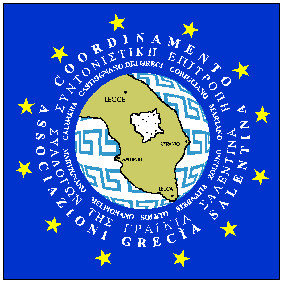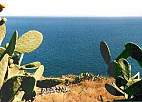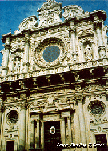
Would you like to spend beautiful HOLIDAYS IN SALENTO?
![]()
In this region of Salento, the remains of this important past are many: Orthodox monasteries, abandoned "casali" or villages, Byzantine churches and crypts, place names, celebrations, dances, songs and a very vast literary output. The great humanist Antonio De Ferraris, known as the Galateo (Galatone, 1448-1517), described this region in the famous book «De Situ Japygiae». Furthermore his family spoke Greek and observed the Greek-Orthodox rite: this rite is nowadays almost completely forgotten, but at the time of the Byzantine rule it represented the standard in the Terra d'Otranto. Please see: Codice Liturgico Galatone n. 3 foto a, foto b, foto c.
The reasons for the end of this tradition must be sought in the policies enforcing hegemony carried out by the Catholic Church since the Norman conquest of Apulia with Robert the Guiscard (1071), in the fall of Costantinople (1453), in the interruption of the communications with the religious centres of the East, in the Turkish invasion of Otranto and of Salento (1480) and the consequential destruction of the most important Greek-Salentine monastery: St. NICOLA DI CASOLE. This cenobium, together with all others following the ancient monastic Orthodox traditions encoded by St. Basilius the Great and located in the Salentine peninsula (they were thirty-four), used to play not only a religious role, but also especially a cultural one, thanks to the presence of a very rich library (whose manuscripts are now to be found in Turin, Florence, Naples, Venice, the Vatican City, Paris, London, Berlin). Inside of St. Nicola di Casole there existed a school open to whoever wanted to come closer to Greek and Latin literature and civilization.
The campaign of the Normans in Apulia was legitimated by the Melfi Agreement (1059) with Pope Nicolo II, who wanted to put these lands of the border under his control. The fact that the Greek-Orthodox rite, the churches and the "PapadeV" (priests) survived living together with the Roman-Catholic rite in the largest part of Salento even after the Concile of Trento (1563) was originally due to the political intentions of the Normans, who wanted to prevent a Byzantine conquering back this territory.
To them, it was sufficient to introduce feudalism and appoint Latin bishops in the main cities. As to the rest, since they wanted to obtain the social consent, it was not convenient to suppress the Christian Orthodox liturgy, since the mother tongue of the majority of the population was Greek.
The original bilingual composition of the community of the Terra d'Otranto has been recognized many times and the Hellenophone (Greek speaking) area included twenty-five towns. Successively in most of the towns there was a passage from the usage of Greek in the higher sphere of social communication to the usage of Latin (even a learned one) as soon as the Byzantine army along with the Byzantine administration had left the territory of Salento.
Nowadays, this area - known under the name of Grecģa Salentina - is constituted by nine towns, that is: Calimera, Castrignano dei Greci, Corigliano d'Otranto, Martano, Martignano, Melpignano, Soleto, Sternatia, Zollino. In these towns, a part of the population can still speak Griko, the Greek-Salentine language very similar to the language spoken today in Greece (Dhmotikh), and that in Italy is only spoken in the area of Bova in the province of Reggio Calabria.
This important linguistic phenomenon was once studied and described in all its details by the German Linguist Prof. Gerhard Rohlfs. From 1921 he carried out extensive research in the "Grecia Salentina" and expressed the hypothesis, supported by rigorous arguments, that modern Neogreek dialects of Salento and Bova were the natural evolution of the language spoken at the time of Magna Grecia. Among the others, especially Domenicano Tondi (see his writing sample: Grhko keimeno ), and Prof. Sicuro share Prof. Rohlfs' opinion. Other scholars, like Morosi, Parlangeli, Stomeo, Aprile, have maintained, on the contrary, that the "Griko" language is of a peculiar Byzantine origin, because it is quite distinct from ancient Greek, as modern Italian, for instance, differs from Latin.
 Griko_Language_and_Literature
Griko_Language_and_Literature
 Saint Mauros ItaloGreek Church - O ItaloEllhnikoV NaoV tou Agiou Maurou
Saint Mauros ItaloGreek Church - O ItaloEllhnikoV NaoV tou Agiou Maurou Ancient_Churches:_Same_style_between_Salento_and_Crete
Ancient_Churches:_Same_style_between_Salento_and_Crete A picture itinerary through the ancient witnesses of Eastern Christianity of Salento (1)
A picture itinerary through the ancient witnesses of Eastern Christianity of Salento (1)Fwtograjiko dromologio dia mesou tiV arcaieV marturieV thV AnatolikhV CristianosununhV tou Salento (1)
Itinerario fotografico attraverso le antiche testimonianze della Cristianitą Orientale del Salento (1)
 A picture itinerary (2) Fwtograjiko dromologio (2) Itinerario fotografico(2)
A picture itinerary (2) Fwtograjiko dromologio (2) Itinerario fotografico(2)  A picture itinerary (3) Fwtograjiko dromologio (3) Itinerario fotografico(3)
A picture itinerary (3) Fwtograjiko dromologio (3) Itinerario fotografico(3)
 A picture itinerary (4) Fwtograjiko dromologio (4) Itinerario fotografico(4)
A picture itinerary (4) Fwtograjiko dromologio (4) Itinerario fotografico(4)
 Byzantine Monuments in Italy Buzantina Mnhmeia sthn Italia Monumenti Bizantini in Italia
Byzantine Monuments in Italy Buzantina Mnhmeia sthn Italia Monumenti Bizantini in Italia
 Appeal for San Mauro Epistrateuoume uper ton Agio Mauro Appello pro San Mauro
Appeal for San Mauro Epistrateuoume uper ton Agio Mauro Appello pro San Mauro
 Antonio Greco, Vocabolario Griko-Italiano, Italiano-Griko, Castrignano dei Greci, 1998
Antonio Greco, Vocabolario Griko-Italiano, Italiano-Griko, Castrignano dei Greci, 1998
 Mauro Cassoni, Vocabolario Griko-Italiano a cura di Salvatore Sicuro, Argo, Lecce, 1999
Mauro Cassoni, Vocabolario Griko-Italiano a cura di Salvatore Sicuro, Argo, Lecce, 1999
 Carmine Greco, Gewrgia Lamprogiwrgou,
Lessico di Sternatia - Lexiko tou Ellhnikou IdiwmatoV thV SternatiaV, Edizioni del Grifo, Lecce, 2001
Carmine Greco, Gewrgia Lamprogiwrgou,
Lessico di Sternatia - Lexiko tou Ellhnikou IdiwmatoV thV SternatiaV, Edizioni del Grifo, Lecce, 2001
 Dictionary, Language, Literature - Lexiko, Glwssa, Logotecnia ON LINE (by Grecģa Salentina org)
Dictionary, Language, Literature - Lexiko, Glwssa, Logotecnia ON LINE (by Grecģa Salentina org)
GRUPPI MUSICALI GRECO SALENTINI - GREEK SALENTINE MUSIC GROUPS
Dal 23 al 26 gennaio 2001 il Presidente della Repubblica Ellenica
Kostis Stefanopoulos č stato in Italia in visita ufficiale, su invito del suo omologo
Ciampi. Il giorno 25 gennaio č stato nelle zone ellenofone del Salento, in particolare a Calimera, Martano e Sternatia (qui, alle 17 circa presso la sede del Coordinamento delle Associazioni della Grecģa Salentina, in Piazza Castello). Il Presidente era accompagnato da imprenditori greci e giornalisti, mentre
il Governo era rappresentato dai sottosegretari all'Economia G.
Zafiropoulos e agli Esteri G. Niotis.
 KLIK EDW GIA NA DEITE THN ELLHNIKH SELIDA
KLIK EDW GIA NA DEITE THN ELLHNIKH SELIDA
 Report
on the Iraklion Congress
Report
on the Iraklion Congress
Questionnaire
-
Please provide your comments about our Website. Would you like to join the "Coordinamento Associazioni Grecģa Salentina"?
Would you like to know more about Salento?
Just write to us, we will reply to you very soon!

 Links to other sites on the Web
Links to other sites on the Web 






This Website since 1 May 1999